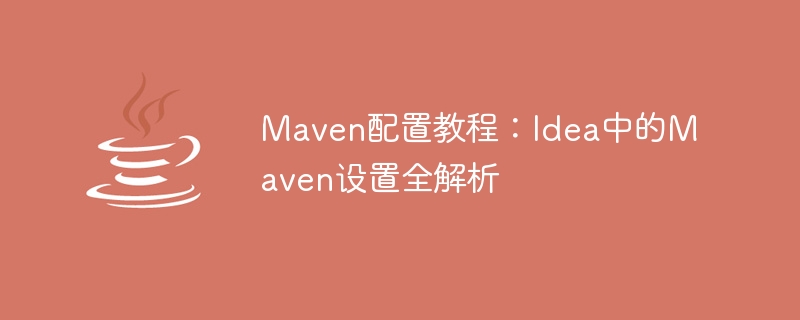Home >Java >javaTutorial >Detailed tutorial on complete resolution of Maven settings in Idea
Detailed tutorial on complete resolution of Maven settings in Idea
- WBOYWBOYWBOYWBOYWBOYWBOYWBOYWBOYWBOYWBOYWBOYWBOYWBOriginal
- 2024-01-28 10:09:081369browse

Maven configuration tutorial: Full analysis of Maven settings in Idea, specific code examples are required
1. Introduction to Maven
Maven is a powerful project management tool , which can help developers automatically build, test and deploy Java projects. It manages project dependencies through a central repository and provides many commonly used plug-ins to simplify the project management process. For developers who use Idea for Java development, it is very necessary to learn and configure Maven.
2. Installation of Maven in Idea
First, we need to install the Maven plug-in in Idea. Open Idea, click File -> Settings on the top menu bar, select Plugins, enter "maven" in the search box, find the Maven Integration plug-in, and click Install to install.
3. Create a Maven project
Creating a new Maven project in Idea is very simple. Click File -> New -> Project on the top menu bar, select Maven, and click Next. On the Next page, fill in the GroupId and ArtifactId, and click Next. On the next page, select the location of the project and other options, then click Finish. In this way, a basic Maven project is created.
4. Configure Maven's settings.xml file
Maven's configuration file is settings.xml, which contains some global settings, such as the URL of the central warehouse, the location of the local warehouse, etc. In Idea, we can easily edit the settings.xml file. Click File -> Settings on the top menu bar, select Build, Execution, Deployment -> Build Tools -> Maven -> User settings file, and click the Edit button on the right to edit the settings.xml file.
5. Add dependent libraries
In Maven projects, we usually need to use some third-party libraries to implement various functions. In Idea, adding dependent libraries is very simple. First, find the pom.xml file in the project, which is the core configuration file of the Maven project. In the pom.xml file, you can add the
<dependency>
<groupId>org.springframework</groupId>
<artifactId>spring-core</artifactId>
<version>5.0.0.RELEASE</version>
</dependency>After adding the dependent library, Idea will automatically download the library and add it to the project in the classpath.
6. Building and running Maven projects
In Idea, it is also very convenient to build and run projects through Maven. First, find the "Maven Projects" window at the bottom of Idea. Expand the project and under the "Lifecycle" menu, you can see commonly used build commands, such as clean, compile, package, etc. Click the corresponding command to perform the corresponding operation.
If you need to run a Maven project, you can select the "Plugins" menu in the "Maven Projects" window, find the corresponding plug-in, such as spring-boot plug-in or tomcat plug-in, and then select the corresponding command, such as spring-boot :run or tomcat7:run, click the run button to start the project.
7. Configure Maven's mirror source
By default, Maven uses the central warehouse to download dependent libraries. However, since the central warehouse is abroad, sometimes the download speed is very slow. In order to improve download speed, we can configure Maven's mirror source. In the settings.xml file, you can add the
<mirrors>
<mirror>
<id>aliyun</id>
<name>Aliyun Maven Mirror</name>
<url>https://maven.aliyun.com/repository/public</url>
<mirrorOf>central</mirrorOf>
</mirror>
</mirrors>After the configuration is completed, Maven will download the dependent libraries from the mirror source, and the speed will be significantly improved.
8. Summary
This article details the process of configuring and using Maven in Idea, and provides some specific code examples. By learning and mastering this knowledge, I believe readers can better use Maven to manage and build their own Java projects. Hope this article is helpful to everyone!
The above is the detailed content of Detailed tutorial on complete resolution of Maven settings in Idea. For more information, please follow other related articles on the PHP Chinese website!

